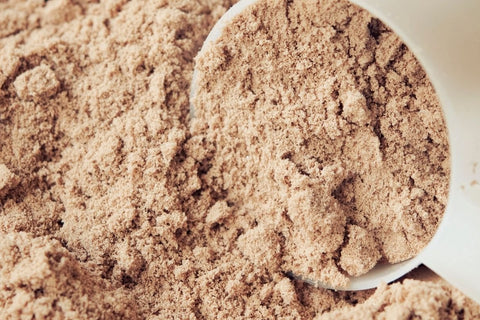Let's be honest- if you've spent any time in the fitness world, you've probably heard the famous "1 gram of protein per pound of body weight" rule.
While this isn't necessarily wrong and is, in fact, better than consuming very little protein, it's a bit like saying everyone should wear size ten shoes.
What if you have bigger feet and need to go up a size or two? Simply put, your protein needs are as unique as your training journey, and determining your protein intake accurately is central to achieving your desired muscle mass.
This comprehensive guide aims to help you with the same by providing evidence-based recommendations while considering individual factors influencing protein requirements.
Individual Factors That Affect Your Protein Needs

The complexity of determining your protein intake lies in how your body utilizes protein based on your unique physiological state, training parameters, and overall goals.
Here are the two most important factors that affect your needs:
Training Status
Morton et al. (2018) in the British Journal of Sports Medicine reviewed protein supplementation in resistance training and found that the effect on muscle strength and size is more pronounced in trained individuals than in novice lifters.
Furthermore, as you advance in your training journey, protein needs typically increase due to:
- Enhanced ability to handle training volume
- Greater muscle mass requiring maintenance
- Improved capacity to utilize protein for muscle growth
- Higher recovery demands from intensive training
Thus, as training experience increases, protein intake might also need to vary to ensure continued muscle development.
Body Composition and Training Goals
Protein requirements must be calibrated according to your specific circumstances and objectives:
|
Training Phase |
Protein Requirement |
Rationale |
|
Bulking |
1.6-2.2g/kg |
Supports muscle growth while minimizing fat gain |
|
Cutting |
2.0-2.4g/kg |
Preserves muscle mass during caloric deficit |
|
Maintenance |
1.6-2.0g/kg |
Maintains existing muscle mass |
For individuals with higher body fat percentages, calculating protein needs based on lean mass or goal weight provides more accurate targets. This approach prevents the overestimation of protein requirements while ensuring adequate muscle preservation and growth intake.
Age-related factors also warrant consideration. Research indicates that older athletes (40+) may require slightly higher protein intakes due to anabolic resistance - a decreased muscle protein synthetic response to protein intake and resistance exercise that occurs with aging.
Also Read: High Protein Dinner Ideas
How Much Protein Do I Need To Build Muscle?

You now understand the different factors to consider while determining your protein needs. But you'd still like a practical estimate that you can implement today without hassle.
Thankfully, research has consistently shown reliable ranges for optimal muscle growth, allowing us to establish clear guidelines while avoiding unnecessary complexity. Here are the key protein intake ranges for individuals engaging in regular resistance training:
- Minimum effective intake: 1.6g per kg of body weight (0.73g per pound)
- Optimal range: 1.8-2.2g per kg (0.82-1.0g per pound)
- Upper limit: 2.4g per kg (1.1g per pound)
To put this into practical terms:
- For a 70kg (154lb) individual: 126-154 g protein daily
- For an 80kg (176lb) individual: 144-176g protein daily
- For a 90kg (198lb) individual: 162-198 g protein daily
These ranges have proven effective across multiple studies. They provide sufficient protein for muscle growth while remaining practical, as they combine whole foods with supplementation if needed.
Important considerations:
- Start at the lower end of the range (1.6g/kg) and assess your progress.
- Increase intake gradually, if needed, based on your response and recovery.
- During caloric deficits, lean toward the higher end of the range.
- If you carry significant excess body fat, calculate your needs based on your lean mass or goal weight instead of your total body weight.
Common Pitfalls and Myths
Scientific literature has extensively examined several prevalent myths about protein intake that might influence your decisions. Here are a few:
Protein Intake and Kidney Function
A persistent concern regarding high-protein diets is their alleged negative impact on kidney function. However, research consistently demonstrates that increased protein intake poses no risk to individuals with healthy kidney function.
A comprehensive review in Advances in Nutrition found no significant evidence of kidney damage in healthy individuals consuming higher than average amounts of protein daily. Nevertheless, those with existing kidney conditions should consult healthcare providers before modifying their protein intake.
Protein Absorption Limit
The notion that the body can only absorb 30g of protein per meal is a significant oversimplification. Protein absorption occurs through a complex process involving various digestive enzymes and transport mechanisms. Research indicates that the body can effectively process varying amounts of protein, though the absorption rate may differ.
Factors influencing absorption include:
- Protein source and quality
- Overall meal composition
- Individual digestive capacity
- Total protein amount
Complete Proteins Must Be Consumed in Every Meal
A persistent misconception in the fitness community is that complete proteins (those containing all essential amino acids) must be consumed in a single meal for effective muscle building. This belief has led many to restrict their protein sources or unnecessarily over-complicate their meal planning.
Research has found that the body maintains an amino acid pool that effectively combines amino acids from different protein sources consumed throughout the day. This means that as long as you consume adequate amounts of various protein sources within a day, your body can effectively utilize them for muscle protein synthesis.
This understanding is particularly relevant for:
- Plant-based athletes who combine different protein sources
- Individuals following time-restricted feeding patterns
- Those who prefer varied protein sources throughout the day
What matters most is reaching your total daily protein target and consuming adequate amounts of all essential amino acids throughout the day rather than obsessing over complete protein sources at each meal.
Best High Protein Snacks to Build Muscle: Making Every Bite Count

In the journey of muscle building, the role of strategic snacking often goes underappreciated.
While primary meals form the foundation of your nutrition plan, well-chosen snacks can significantly impact your protein intake, recovery, and overall progress. The challenge lies not just in finding high-protein snacks but also in selecting options that support both muscle growth and digestive health—a factor that many overlook in their fitness journey.
100 Cal Snacks addresses these challenges with a thoughtfully crafted line of protein-rich snacks explicitly designed for fitness enthusiasts who prioritize performance and digestive health. Our Chocolate Protein Bars, Peanut Butter Protein Bars, and Barbeque Protein Puffs are delicious, keto-friendly, gluten-free snack options.
Here's what makes these snacks particularly gut-friendly:
- Portion-controlled at 100 calories for optimal digestion
- High-fiber snacks supporting gut microbiome health
- Natural antioxidants promoting gut barrier function
- Zero-sugar alcohols or artificial sweeteners that commonly cause bloating
- Organic ingredients ensure clean, natural nutrition
Try out our light, high-protein, keto-friendly snacks today, and let us know how you like them!



